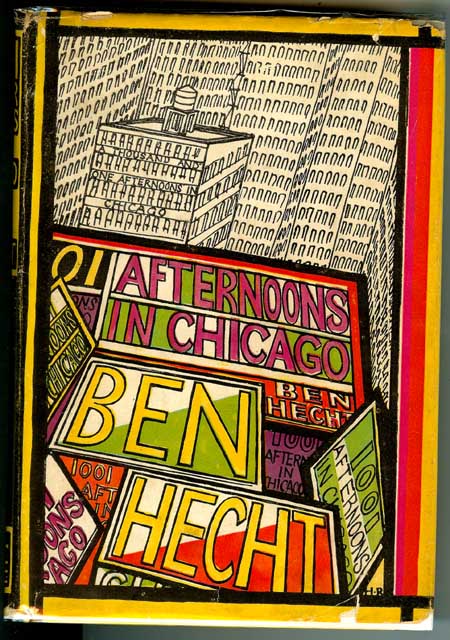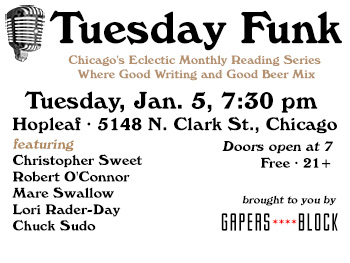| « This Much Is True Chicago @ The Hopleaf | More Loving Frank Resources » |
Reviews Tue Aug 10 2010
Jazz Age Fly On The Wall

Ben Hecht (1894-1964) was best known as a screenwriter. Called "the Shakespeare of Hollywood," who "used Oscars as doorstops," his credits include more than 70 films, including Spellbound, Wuthering Heights, and The Front Page. He got his start and many of his subsequent ideas here in Chicago. In 1921 he began a column for the Chicago Daily News called "1001 Afternoons in Chicago," later collected into a book. His editor at the Daily News, Henry Justin Smith, said "1001 Afternoons" represented a new concept in journalism, which today we'd call creative nonfiction: "the idea that just under the edge of the news, in this urban life there dwelt the stuff of literature. He was going to be its interpreter."
1001 Afternoons consists of little vignettes of life in Chicago in the '20s, each accompanied by at least one stylized, wood block style Herman Rosse illustration. Not surprisingly, in many of the stories you can see in the bones of the screenwriter Hecht would become. The best of these "scruffy time capsules" are cinematic. You feel the taut energy of a popcorn thriller in "The Man Hunt," where Hecht projects himself into the mind of "Lucky" Tommy O'Connor, hiding out in an unknown location (he'd escaped from prison three days before he was to be executed for the murder of Chief Paddy O'Neil). "The Thing in the Dark", the story of a landlady unnerved by the peculiar habits of boarde, held a similar tension.
Some are great self-contained stories of unique situations and ironic twists. "The Auctioneer's Wife" tells of an auctioneer inadvertently seducing his future wife with his overwrought sales pitches. She still fell for them once they were married, only then it was his money she spent on the trumped-up junk he sold. He chooses money over love, and loses her when he confesses his salesmanly chicanery ("I'll never marry again," he moaned. "I ain't the kind that makes a good husband. A good husband is a man who is just an ordinary liar. And me? Well, I'm an auctioneer"). "The Indestructible Masterpiece" is a great barroom tale about getting by in leaner years, covering a bar tab with the collateral of a worthless painting insured for a large sum that never comes. "Fa'n Ta Mig!" is a great character sketch of a neighborhood eccentric, a drunk Norweigian sailor always searching for a new religion, who's convinced it's all for naught and the devil is once again after him every time there's a thunderstorm.
There are great zeitgeistian time capsules to be found. "Where The 'Blues' Sound" is a portrait of a racially mixed night club. "Satraps at Play" tells of a rowdy vaudeville show where throwing coins at the performers is de rigueur.
"Nirvana" is a portrait of a flapper in Uptown. "The Exile" tells of a brief exchange he had with Bill Haywood, founder of the Industrial Workers of the World. In "Fantastic Lollypops" he's a fly on the wall at the rehearsal of a new Prokofiev opera.
The essays that don't work as well for me are the ones that are more flight-of-fancy descriptions than stories ("Fog Patterns," "Night Diary," "Ripples," "The Lake"). They show he has an eye for cinematography and stage setting...but in the cinema, there would be people in those scenes, doing things. He seemed to be striving for poetry but they felt rambling and hastily thrown together to meet a deadline. Frankly, I found them so dull they slackened my reading pace considerably.
Neither was I impressed with the essays in which he's clearly looking down at his subjects. There's "Vagabondia," in which he sneers at smug middle class travelers. There's his uncomfortable feelings toward beggars in "Ill-Humoresque." The most offensive in this vein is "The Snob" in which he talks to a plain young girl on a train, "a slavey on her day off." When she tells him her pockets are full of notes instructing people what to do in the event of her demise, he concludes "alas, [she] is a snob. She writes her own obituaries. Alive she can think of herself only as the slavey at whom the boys giggle and call names. But dead, she is the 'deseased' - the stately corpse commanding unprecedented attention."
Clearly Hecht has no Studs Terkelesque love for the common man and could be quite the snob himself, though for the most part he's not so much contemptuous toward his subjects as occasionally frustrated by his inability to extract a story from them. In contrast to "The Snob," "The Mother" is a touching, simply told story of a hardscrabble mother fiercely loving and defending a troubled daughter who has no respect for her.
All in all, I found 1001 Afternoons a bit hit-or-miss. That's to be expected in any sort of collection, though, and the hits outweigh the misses. 1001 Afternoons is occasionally breathtaking, occasionally frustrating, a fly on the wall view of Chicago in the Jazz Age and a peek at the roots of a cultural icon.










Aharona / August 10, 2010 11:54 PM
This book sounds delightful! I am very interested to read a few of these stories!